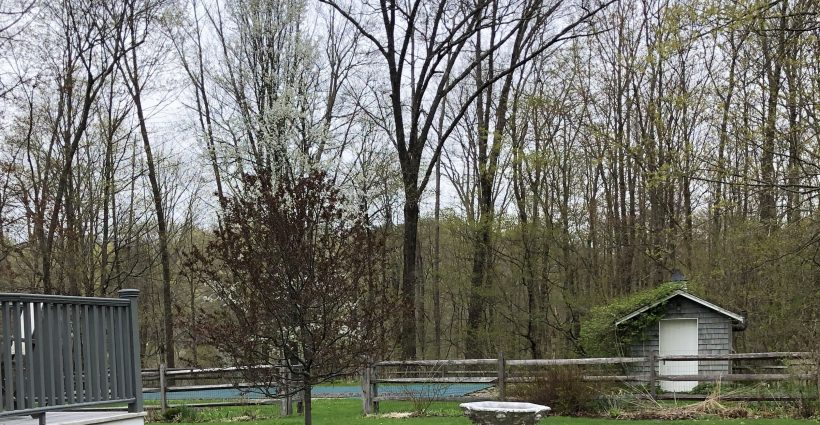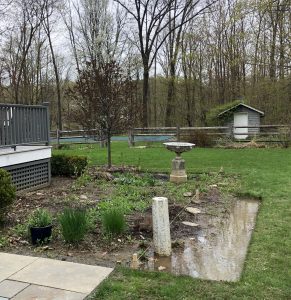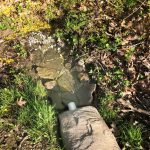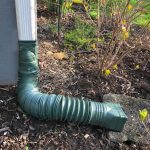designed for the way women work.

Do you have drainage problems in your garden?
Category: How-To Projects, Presenting "The Curious Gardener"
It’s been a rainier winter and spring than most here in the northeast, and many of us are having issues with drainage in places we never had them before. In some cases it might be best to wait and see if the problem persists or if the excessive rainfall is just an aberration.

In my case I have an herb garden that hugs the back of our house and extends about 12’ off the deck and patio. This spring I noticed a portion of the herb garden was under water after a heavy rainfall and the water was still there 24 hours later!
The water is coming from a hill behind our house. It’s a gentle slope that levels out about 50 feet from the house. It has never been a problem before, but this year the water is flowing right down into the garden – and with the water table being so high there’s no place for it to go. Since I want to start planting my herbs, many of which are annuals, I don’t want to wait to see if the rains are going to stop. I want to take preemptive action.
If you decide to go ahead and do something about your drainage issues, here are some of your options. This is not a complete list but it covers the basics and includes the DIY options we considered.


First, figure out the source of the water. If it’s coming from a gutter downspout you can usually extend the downspout well beyond the house so the water doesn’t flow back into the house. That’s easy!
If you have a sump pump in your basement that is discharging water too close to the house consider having an underground pipe installed that’s connected to the sump pump and leads the water where it can drain into a low lying spot away from the house. The downward slope of the pipe should be at least 1% or 1/8” per linear foot. We’ve done that too.
Because our water is coming from the hill behind us, and it’s not a steep hill, we decided on two fairly simple procedures, a drainage ditch and a raised bed. First we dug a ditch next to the garden, about 8-10” deep and 18” wide, to catch some of the water and hold it as it slowly drains into the soil. We filled it with drainage stones we purchased at M&M Garden Center & Supply in Patterson and then put a piece of landscape fabric over the stones. We left just enough room to put the turf we had removed back on top. For the raised bed portion we installed boards on 3 sides of the garden to help support a higher level of soil. It’s effectively a raised bed though only 4” of the boards are showing above the level of the grass, so it doesn’t really read as a raised bed – a choice I made for aesthetic reasons. From the inside of the garden the soil will fill the enclosure to the top.
A raised bed is one of the simplest ways to improve drainage if you have a soggy, slow draining base to your garden. Put some drainage stones at the bottom to improve drainage further.
Another option we considered was to dig a swale, redirecting water from the top of the hill down towards a wetland area that is planted with grasses and willow shrubs. That seemed like a last resort since it would involve a lot of digging. The principle of this type of swale is that it creates a low area between two ridges, like a creek bed. Some people line theirs with stones and plantings to make it a decorative feature in their landscape.
For permaculture gardeners there’s a kind of swale that absorbs the runoff and provides a good environment for growing and irrigating plants in a natural way. With this kind of swale you follow the contour of your hill and create a berm on the low side of the depression using the soil you dug out for it. The berm acts like a sponge, retaining water to fulfill the needs of your plants.
Creating a rain garden, also called a stormwater garden, is an option as well. It is a garden planted in a depression or low area of your property where rainwater collects. By planting suitable moisture-loving plants, it helps the rain water gently absorb into the ground.
With sunny skies and these tips, hopefully your drainage problems will soon be a thing of the past!



Do you have photos of the “drainage ditch and raised bed” solution? I have a similar problem, but I don’t want to dig up the whole backyard yard, which the irrigation people recommend. I have raised bed materials ready to go, but it seems ridiculous to construct them without solving the drainage problem.
Not sure I visualize your “drainage ditch and raised bed” solution.
I will send you an email with photos. The project is not complete, but I can show you the work we’ve done thus far and it seems to be working.
I would to see photos of the suggested solutions to this garden problem
Could I receive a picture of your drainage problem. My problem is behind my house and its not all bad because it supports my fern garden. But the grass in front of the garden is always soggy because its low and it doesn’t get much sun there.
Thanks,
Judy
Hi Dorian! I also want to see the after photo of the raised bed!
I have a drain problem due to ledge alongside my house. The water if now eroding my paved driveway. I had intended to put a drain to the street but was told in the winter, it would turn into an ice rink at the end of the driveway. So am now considering a rain garden.
My question is – when it doesn’t have water in it, doesn’t the bottom just become a pile of weeds due to the seeds that wash into it? That is what I have along the driveway right now.
I’m also having a problem finding someone in the area to talk to about building one. One needs to be both a drainage expert and a landscaper.
Thank you for your article, it is particularly interesting as we may have a similar problem, not with a hill but a small gradient to the land.
We too would love to see some pictures of your drainage ditch and raised garden
to give us some ideas of what can do.
Many thanks
Lin Pollard